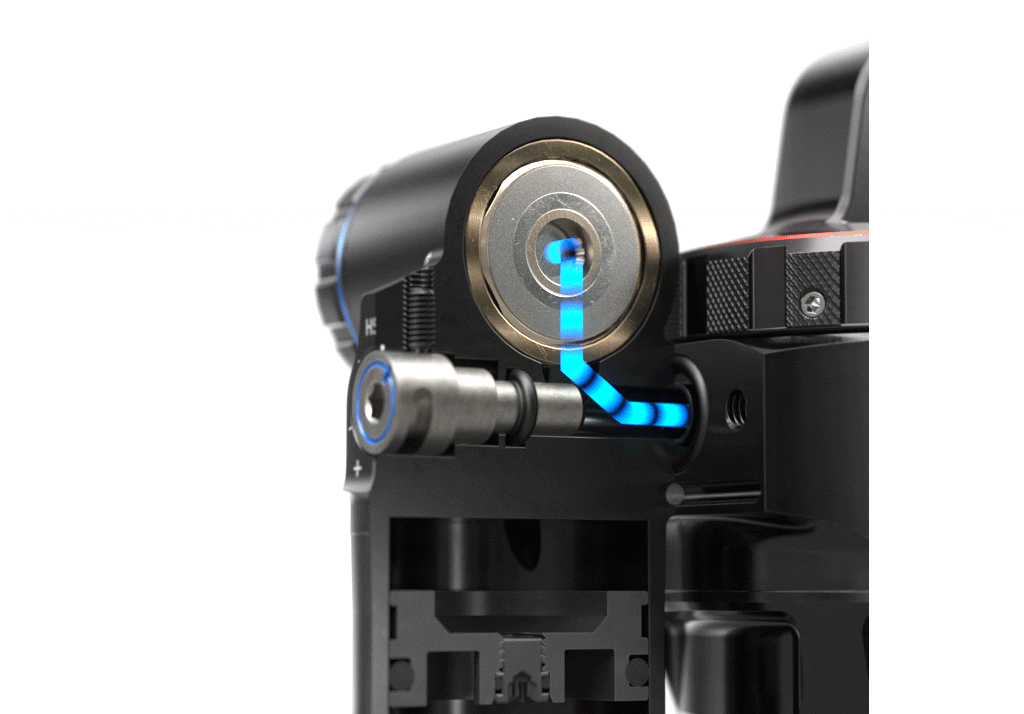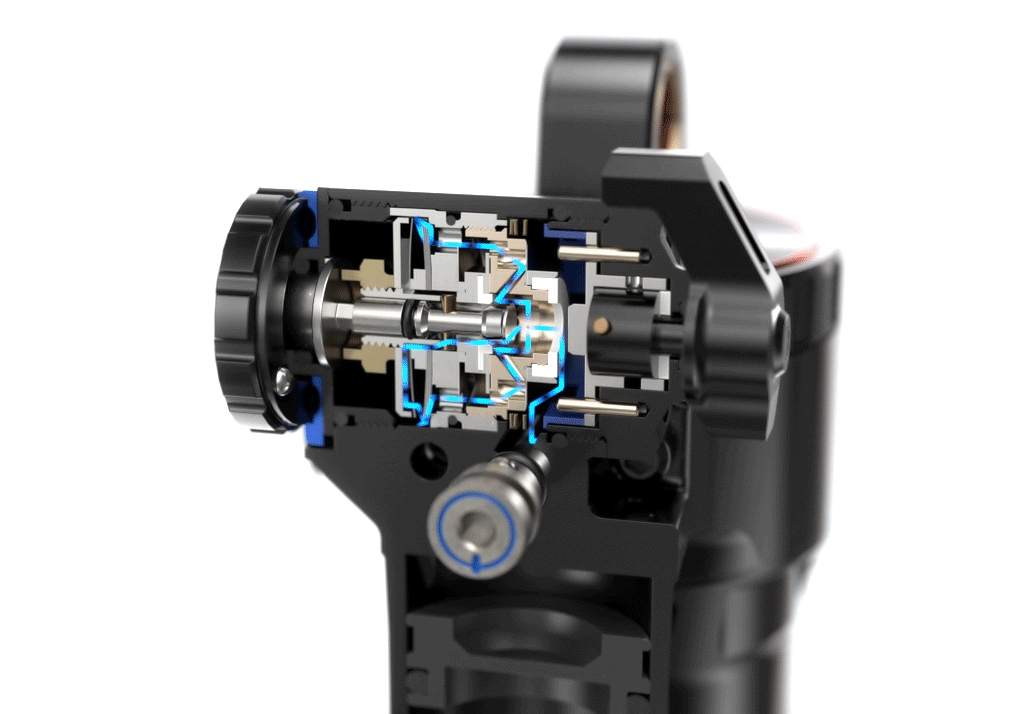REAR SHOCK RC2T DAMPER
What Does RC2T Mean? | So, How Does RC2T Work? | Other Cool Features
To many riders, rear shocks seem to be a bit of an enigma. Their name does a good job of implying what they do: soak up impacts from the rear wheel. But rear shocks do so much more than that—they also keep tires in contact with the ground, increase rider control, and decrease fatigue from riding your favorite techy trail again, and again. But since they’re not front-and-center like forks, and a bit harder to replace or upgrade based on fitment, they end up being a bit of a mystery.
We’re here to tell you that rear shocks utilize much of the same technology that goes into a fork—an air spring, chassis, and damper, complete with Compression and Rebound adjustments—just housed in a smaller, more compact package. We’ll dive into the damper technology—known as RC2T—that plays a huge role in why the all-new Super Deluxe and Super Deluxe Coil are changing the way we look at damping.
What does RC2T mean?
R for Rebound, C for Compression, 2 for the number of Compression Adjustments—High Speed Compression (HSC) and Low Speed Compression (LSC), and T for Threshold.

Before Charger 3 was developed for our 2023 Fork Lineup, there was RC2T. After years of refining the Super Deluxe line of rear shocks, Senior Design Engineer Tim Lynch had some big ideas on ways to redesign the system based on feedback and experience. Lynch and the rear shock team knew one of the major updates they wanted to make was to truly fine-tune compression adjustments. When Lynch began investigating ways to affect the compression damping, he discovered a way to completely separate High Speed Compression (HSC) from the Low Speed Compression (LSC) damping adjustments. If this sounds familiar, you’re right—it’s the same concept that we cover in our Charger 3 article.
The same theory applies in rear shocks. Having completely independent HSC and LSC adjustments means that you can set your HSC without affecting your LSC—and vice versa—meaning you have complete control over how your rear shock feels for exactly how you like to ride. Prefer more support in berms and transitions but want more suppleness in rock gardens and drops? Add more damping in the LSC and remove some damping from the HSC. Or are you looking for more suppleness in low-speed events, but less in high-speed events? Remove damping from LSC and add some to HSC. Set it up for how you like to ride, no confusion or mental gymnastics.
The HSC damping is happening well ahead of the LSC damping. What that allows us to do is adjust those two things completely independently. There is no crosstalk.
–Tim Lynch
So, how does RC2T work?
Before we dive in, we strongly recommend checking out our article on Charger 3. We cover damper theory that will help with understanding rear shock damping. Don’t worry, we’ll wait…
Welcome back, let's jump right in!

Oil flowing from the shock body into the reservoir through the HSC circuit, with the adjuster opening and closing.
As the oil is pushed up through RC2T during a compression event, it moves through a hole leading to the reservoir, where it is funneled first through the HSC valve, and then the LSC valve. The same theory from Charger 3 is true here: when both HSC and LSC are Open, oil flows freely through both circuits, allowing for full, easy compression. When LSC is Open, but HSC is closed off, the oil is still restricted through HSC, but it doesn’t affect LSC because, by nature, LSC is slower and requires less oil flow. When we flip it and open HSC but close off LSC, there’s full flow of the oil through the HSC circuit (which comes first) and then the oil moves through the LSC circuit—which includes a harder path and an easier path.

Oil flowing through the LSC circuit. When the adjuster is open (needle is down) the oil can flow through the easy path. When the adjuster is closed (needle is up) the oil must flow through the hard path, creating pressure.
The HSC circuit uses an adjustable orifice to control the amount of oil moving through the system—the size of the orifice directly affects how much oil can get through at a given pressure. The LSC circuit forces the oil through different paths—an easy path with little resistance and a hard path with added resistance (the outside path in the animation above). The easy path flows through the middle of the damper, pushes past a check shim, then continues to the reservoir. However, when the LSC adjuster is Closed, it rotates the LSC adjuster needle up, blocking the port, which forces the oil to go through the hard path where it must push through a shim stack, slowing down the oil flow and creating pressure, which causes more damping. This shim stack is tuned to add damping at low speeds but blow open during high-speed events.
The valves aren't linked to each other as they commonly are in other dampers. That’s been a huge advantage for us in set up—in lowering the complexity to the end user and achieving the goals that we wanted to hit with our specific High Speed or Low Speed Compression damping forces.
–Tim Lynch
Other Cool Features
Another feature that really distinguishes RC2T is that the middle settings of both the HSC and LSC adjusters is the base tune. In traditional dampers, the base tune is considered the “Open” position: when the adjusters are all the way open for the most travel/least amount of damping. However, we wanted to give the rider the ability to tune the way their rear shock feels, so each click of adjustment—whether it’s High or Low Speed Compression—will effectively move the feel of damping toward a lighter or heavier compression tune.

HSC adjustment
When we say “tune,” we’re not talking about music, though this may be music to your ears. The base tune of a rear shock affects how hard or easy it is for the shock to move through travel and is made up of a stack of shims that the oil has to push past as the shock cycles through its travel. A lighter shim stack allows oil to pass through with less force, making it easier to cycle the shock through travel, while a heavier tune—you guessed it—makes it harder for oil to flow through the shim stack, necessitating more force to cycle the shock through travel. But changing a tune is no simple task—it’s not like swapping out air cans or a Bottomless Token. Changing a tune requires a complete teardown of the shock (not for the inexperienced) and in-depth know-how of the order and orientation of the shim stack.

LSC adjustment
We wanted to give riders the ability to have a bigger impact on how their rear shock felt without having to overhaul their rear shock to change the tune. With RC2T, the base tune is set right in the middle of the LSC and HSC adjuster knobs, determined by each frame manufacturer to best suit their specific kinematics. You then have two clicks to decrease damping and two clicks to increase damping for both HSC and LSC. Clicking both adjusters towards Open will decrease the compression damping to the next lightest tune, while adjusting them toward Close will increase compression damping toward the next heavier tune.
You can increase it essentially a tune level or decrease it a tune level. We reduced the number of clicks of adjustment, and instead made a meaningful jump every time you turn one of those knobs, but not so much that you get confused by it.
–Dave Camp
For example, say the bike you just brought home came with has an “M” compression tune, and you’re finding it’s not quite supportive enough for your ride style. Closing both the HSC and LSC will effectively add enough damping to make it feel like you’ve jumped to the next heavier tune, which in this case would be an “H.” The same works vice-versa—if you’re not getting the sensitivity and movement you’d prefer from your rear shock, you can Open both HSC and LSC adjusters to effectively drop a tune, which would be an “L” tune.
As we explained above, the adjustments also work independently of one another, so you can dial in exactly how your rear shock feels. And, as we like to say: set it and forget it. Or change it up for each trail—the choice is yours.

The last significant change we'll talk about here is increased bushing overlap, reducing friction throughout the chassis. We have a great article about bushings in our Friction Story—the theory is similar between forks and rear shocks. In rear shocks, bushings live in the bottom of the air can, above the dust wiper seal, and on the Seal Head/Air Piston.
The damper is built with simplicity in mind so that you can set it and leave it, or you can make micro-adjustments as needed.
–Lindsey Watson
Ultimately, we wanted to give riders more fine-tunability with adjustments that intentionally affect ride feel without adding confusion. With RC2T, each click is so meaningful and exact, you might just think you changed your tune.
RC2T is only available on 2023 Super Deluxe Ultimate and Super Deluxe Coil Ultimate rear shocks and is not backwards compatible. For setup suggestions and specific information about your rear shock, head to the TrailHead app, also available on mobile devices. Check out our FAQ page for service intervals, adjustments, and more. And if you’re a trained professional, check out our RockShox Rear Shock Piston Tuning Guide if you are interested in physically swapping your tune.

Renderings by Ray Bach. Photos by Ian Collins, Mason Mashon, and James Stokoe. Words by Sarah Walter.